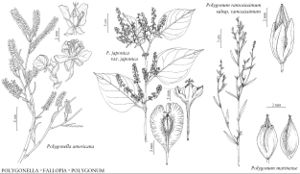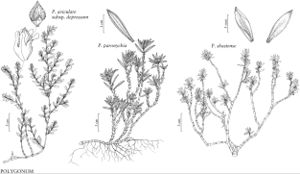Polygonum
Sp. Pl. 1: 359. 1753.
Gen. Pl. ed. 5, 170. 1754.
Herbs, shrubs, or subshrubs, annual (perennial in P. striatulum), homophyllous or heterophyllous, sometimes heterocarpic; roots fibrous or woody. Stems prostrate to erect, glabrous, smooth or sometimes papillous-scabridulous. Leaves cauline, alternate (opposite in P. humifusum), petiolate or sessile; ocrea with distal part persistent, often hyaline, white or silvery, 2-lobed, chartaceous, glabrous, disintegrating into fibers, or disintegrating completely; petiole base articulated with ocrea or not; blade linear, lanceolate, elliptic, ovate, or subround, margins entire. Inflorescences axillary or axillary and terminal, spikelike, or flowers solitary; peduncle absent. Pedicels present or absent. Flowers bisexual, 1–7 (–10) per ocreate fascicle, base not stipelike; perianth nonaccrescent, white or greenish white to pink, campanulate to urceolate, glabrous; tepals 5, connate 3–70% of their length, petaloid or sepaloid, monomorphic or, rarely, dimorphic, the inner usually flat, the outer flat or sometimes keeled and cucullate distally, sometimes of different length than the inner; stamens 3–8 (some may reduced to staminodes); filaments distinct, free or adnate to perianth-tube, glabrous; anthers whitish yellow, pink to purple or orange-pink, elliptic to oblong; styles (2–) 3, mostly spreading, distinct or connate proximally; stigmas 2–3, capitate. Achenes included or exserted, yellow-green, brown, or black, unwinged, (2–) 3-gonous, glabrous. Seeds: embryo curved. x = 10.
Contents
Distribution
Nearly worldwide
Discussion
Species ca. 65 (33 in the flora).
Two sections of Polygonum are recognized here. Section Polygonum is nearly cosmopolitan and best represented in north-temperate regions; sect. Duravia comprises species restricted to North America. K. Haraldson (1978) recognized both sections based on differences in stem morphology, petiole structure, and pollen morphology. J. C. Hickman (1984) described sect. Monticola and included in it species of sect. Duravia occurring mostly in montane habitats, with leaves articulated to the ocreae, one-veined, and not mucronate, proximal leaves lanceolate to round, and styles connate at their bases and neither hardened nor persistent. L.-P. Ronse Decraene and J. R. Akeroyd (1988) and L.-P. Ronse Decraene et al. (2000) included sect. Duravia in sect. Polygonum based on floral and fruit characters.
Similarities in floral structure, fruit anatomy, and pollen morphology have been noted between Polygonella with Polygonum (L.-P. Ronse Decraene et al. 2000). Based on evidence from comparative morphological studies, Ronse Decraene et al. (2004) included Polygonella in sect. Duravia of Polygonum.
Four introduced taxa of sect. Polygonum that were collected in the flora area at the end of the nineteenth century and beginning of the twentieth century appear not to have persisted here and are not included in the keys. Polygonum arenarium Waldstein & Kitaibel and P. bellardii Allioni were reported by B. L. Robinson (1902) from Rhode Island and Massachusetts, respectively. The former resembles P. patulum but has open flowers. Polygonum bellardii is discussed below under P. ramosissimum. Polygonum polycnemoides Jaubert & Spach and P. humifusum C. Merck ex K. Koch subsp. humifusum were reported by J. F. Brenckle (1941). The former was collected in New York City in 1894 and in Idaho in 1940. It differs from all other Polygonum species in having a tube 55–70% of the perianth length. Polygonum humifusum subsp. humifusum is discussed below under P. humifusum subsp. caurianum.
Selected References
Key
Key to the Sections of Polygonum
| 1 | Stems distinctly and ± regularly 8-16-ribbed; leaf blade venation pinnate, secondary veins conspicuous; anthers whitish yellow; nearly worldwide | Polygonum sect. Polygonum |
| 1 | Stems 4-gonous, ribs obscure or absent; leaf blade venation parallel, secondary veins not conspicuous; anthers pink to purple; mostly w North America | Polygonum sect. Duravia |
"/2" is not declared as a valid unit of measurement for this property.


